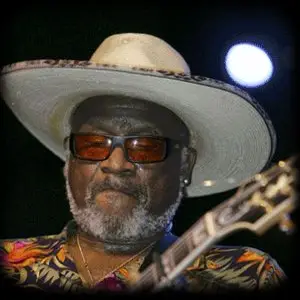TAJ MAHAL
 Taj Mahal was never going to be a Blues purist, but on the other hand just about everything he plays is deeply rooted in the Blues. Music from the East, West, North and South has been absorbed and incorporated in Taj’s work from the earliest days, and he continues to cross musical boundaries like a true Ambassador of Culture, taking his mission around the world, collecting treasures and dispensing his wisdom.
Taj Mahal was never going to be a Blues purist, but on the other hand just about everything he plays is deeply rooted in the Blues. Music from the East, West, North and South has been absorbed and incorporated in Taj’s work from the earliest days, and he continues to cross musical boundaries like a true Ambassador of Culture, taking his mission around the world, collecting treasures and dispensing his wisdom.
Taj and Ry Cooder play a Blues from the early days;
When he graduated in 1964, Taj headed for the West Coast where he formed The Rising Sons with Ry Cooder. They had a single out on the Columbia label but further material sat on a studio shelf until they blew the dust of this forward-looking jewel and issued it as ‘Taj’s Blues’ nearly thirty years later. The band opened shows for many legendary acts and Taj made the acquaintance of Muddy, Wolf, Buddy Guy, Junior Wells, Lightnin’ Hopkins and Sleepy John Estes. Taj’s first three albums were heavily drenched in the Blues but he always incorporated elements from what we now call ‘world music’ in his approach. The 70s saw Taj issue several albums of reggae and calypso influenced fusions like ‘Recycling the Blues’. ‘Mo’ Roots’ and ‘Evolution’ and acclaimed movie scores like ‘Rounder’ and ‘Brothers’. Taj spent most of the 80s kicking back and absorbing the culture in Hawaii, although he toured regularly, and in 1988 released ‘Shake Sugaree’, the first of three lovely children’s albums.
Latin Jazz Blues from the Senor Blues album;
In 1990, Taj scored the Broadway show ‘Mulebone’, which featured Guy Davis, and began to expand his interest in world music. ‘Mumtaz Mahal’ featured Indian classical musicians and ‘Sacred Island’ with The Hula Blues Band had Hawaiian themes. In 1999, Taj’s ‘Kulanjan’ was made with Malian kora player Toumani Diabate, and he describes the result as “a 350 year-old orphan re-united with his birth-parents”. More traditional Blues projects ran in parallel with this work with four albums released in the 90s included the Grammy-winning ‘Senor Blues’. A second Grammy came in 2000 for ‘Shoutin’ in Key’ and a second Hula Blues album ‘Hanapepe Dream’ was released in 2003. Another African album ‘Mkutano….’ in 2005 was followed by the acclaimed and aptly-named overview of Taj’s career, ‘Maestro’ in 2008.
This took Taj’s tally of solo studio releases to 25 albums. A dozen more live albums and compilations and literally dozens of collaborations and movie soundtracks make Taj a formidable recording artist. To be honest, that is not even what he likes best: performing for people is what he really wants to do, especially at open-air Festivals. “I just play to the Goddess of Music, and I know she’s dancing!” Taj Mahal is a beautiful, elegant monument to Love (and a pretty impressive Indian tourist attraction too!)
